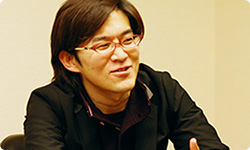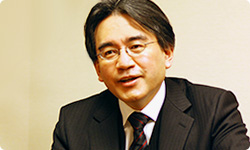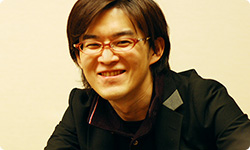5. Girls and Guys
What did you think when first approached about the Nintendo 3DS system?
I wanted to make a fighting game for a handheld. When I first heard the specs for the Nintendo 3DS system and found out that the connectivity wasn’t burdensome, I knew right away that it was right for a fighting game. I had a stockpile of ideas and thought I might be able to do something new with DEAD OR ALIVE.
In exactly what way?
With a fighting game, a fight breaks out when two people meet, so the more connections between people there are, the more kinds of play arise. Beginning with StreetPass, the Nintendo 3DS system has all kinds of avenues for connecting people. If it’s difficult to battle at a game arcade or over the Internet but you have StreetPass, it’s easier to play, so you can once again experience fighting someone.

Basically, fighting someone is fun, but differences in skill rapidly open up and those who get left behind lose motivation. With StreetPass, however, the threshold is lower.
Yes. The StreetPass mode for this game is called Throwdown.15 You can fight against a computer with AI which keeps the fight record of someone you have encountered via StreetPass, and then fight it one time. I hope players will experience fighting all kinds of people that way. One other feature of gameplay that we tackled was Tag Challenge16, in which you pair up and fight opponents. The way fighting games are designed makes players’ skill levels apparent. So if you battle someone at a different skill level, the matches can easily become one-sided. In times like that, players can enjoy a situation different from a regular face-off by forming a pair to defeat the computer. 15Throwdown: A mode in which you receive a challenge from a player you have encountered via StreetPass. Then you can fight a computer with AI based on that player’s fight record. 16Tag Challenge: A mode in which you form a pair and fight a strong opponent.
It must have been hard to nail the frame rate.17 17Frame rate: The number of times in one second that the image on the screen is refreshed.
Yes. Players who really like to throw themselves into a fighting game can turn off the 3D display and play in 2D at 60 frames per second (FPS) - twice that of the 3D.
So there’s a way to enjoy the characters in 3D, or you can tackle the fighting aspect of the game at 60 FPS.
We leave the choice up to the players, but I think we provided some good options.
Were you able to realise aspects of the game unique to handhelds?
Yes. Being able to take it to a friend’s place is one appeal of a handheld, so I hope people who don’t know much about fighting games will play it and realise just how fun fighting games can be.
How did it feel to see your beloved DEAD OR ALIVE characters moving around in 3D in the world beyond the small window of the screen?
The staff members who have worked on games for a while say that it’s the biggest surprise they have had since the jump from sprites18 to 3D modeling. Once you actually see it, you feel like you can touch the images. 18Sprite: A way of integrating characters and background using hardware. This method was used in the Famicom and Super Famicom systems.
Those great characters feel even more real.
Yes. Take the popular movie Avatar19, for example. Beforehand, many people thought they wouldn’t take to characters that were blue like that, but when they saw them in the movie theater, they immediately fell for them. I think that’s because of the increased sense of reality created by 3D images. What you see through that window will seem completely different, like those female fighters aren’t just showing on a screen, but are actually there. 19Avatar: An American movie directed by James Cameron and released in 3D in 2009.
I bet Team Ninja’s modellers and animators really invested themselves in tuning the characters.

Yeah, they did. We actually call them “girls” rather than characters. (laughs)
Girls? (laughs)
They aren’t things, but people. We would be happy if after release even one more person comes to see them that way.
There’s a unique appeal to their attractiveness. Maybe that’s because you have worked as if your life depended on it to make them attractive ever since the days when you didn’t have many polygons20 to work with. In Team NINJA, where does that dedication come from? 20Polygon: In computer graphics, a multi-sided plane figure used to represent three-dimensional shapes. Each polygon is two-dimensional, but assembling them results in a three-dimensional model.
At first, we determine their nationalities and personalities, but later on, as we develop that information into the girls, the staff members add in their own various personal touches.
Everyone adds to them?
Yes. Of course, several of the staff members have very specific ideas.
But taste in women varies quite a lot. (laughs)
Yes. Some of the men on the staff really like a particular girl and will only offer an opinion on that particular character. Those feelings help the girls to grow up, so to speak. (laughs)
So the girls’ settings are much deeper than is immediately apparent.
When a developer says, “She wouldn’t do that,” it may just be because that side of her never showed up before, but for that developer, the character already exists, so it’s certain! (laughs)
The characters grow coherently rather than fall apart because you are a group with a shared vision. By the way, how do the female members of the staff look at the male staff members while all this is going on? (laughs)
I’m scared to know, so I don’t ask! (laughs) What’s interesting is how the women on the staff describe a male character as “this guy.”

So there’s “girls” and “guys.” (laughs)
Yes. They say things like, “I want these guys to dress like this.”
Nice! (laughs) You all really like the characters! I think today I finally got an idea of why this game has such glamour. (laughs)
We have experienced for ourselves how, when a game has appealing characters, it is always because there is someone watching behind the scenes who invests each character with a unique personality.
You view them as something living. Do your opinions differ sometimes?
Yes. More often than for the central design of the game. Then we argue! (laughs) It’s easier to speak objectively about certain contents of the game, but when it comes to subjective likes and dislikes... emotions get involved.
Ahh, emotions. (laughs)
Yeah. (laughs)